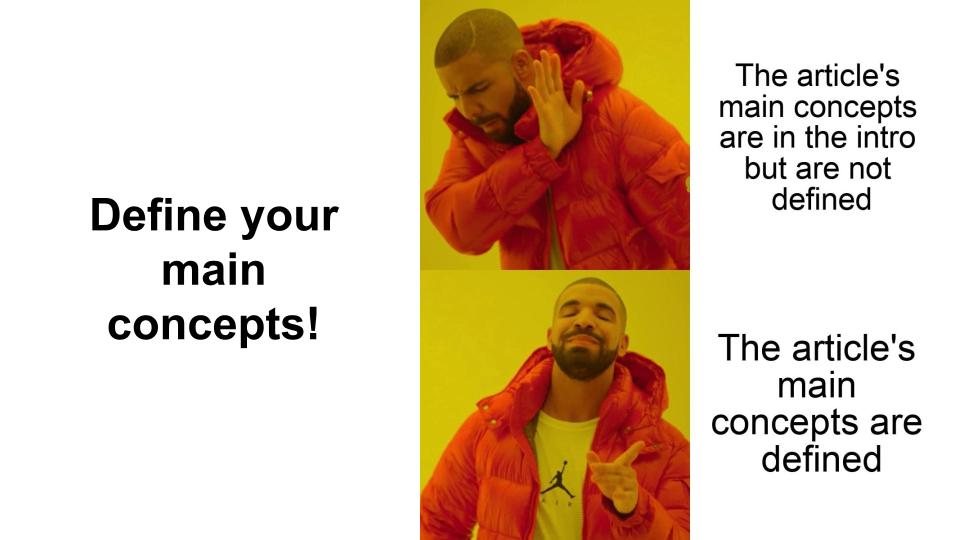What is an introduction?
Empirical research articles in the social sciences require, among other parts, a title, an abstract, and an introduction.
Introductions in social science articles are short — about 3 to 6 paragraphs, depending on the journal and approach. They are at the beginning of empirically-based research articles in sociology, psychology, and political science.
- What is an introduction?
- It’s all about concepts
- So What? Articles must make at least one contribution to the social science literature
- Introductions are where you explicitly state the Knowledge Gap
- Approaches to introductions in sociology
- A sentence-by-sentence investigation of an excellent introduction
- Introductions: The Bottom Line
It’s all about concepts
The through-line of the article are concepts. All major concepts must be present and defined. The author must link these concepts together.

The introduction is a series of statements about the concepts and their relationships to each other. A major statement within the introduction is knowledge gap and contribution of the article to the scientific literature.
So What? Articles must make at least one contribution to the social science literature
A good introduction carries a heavy burden. It must cite relevant literature, state the research topic, pose the research question, and answer “So What?”
When social scientists read your research paper, they ask, “So what?” Or, “What is the contribution of this article to the literature? Why should I read this?” In other words, “This article exists… so what if it does? Who cares?”
Articles should be worthwhile for the reader and provide them with new knowledge.
There are three major contributions an article can make to the social sciences
Concepts and Theory
It helps us understand extant concepts and theories in a new way, or provides a set of newly useful concepts or theories to explain related phenomena.
Methods
It contributes to data or methods, e.g. new data, refined data, new methods, etc.
National knowledge
Whereas the article is not new in terms of concepts, theory, data, or methods, with this article we can understand the nation (or nations) that are studied in the article. Whereas some, especially in the West, would consider “national knowledge” a minor contribution, for many countries of the Global South and others outside of the West, contributions to better knowledge of the nation can be a worthwhile contribution.
After the abstract, the introduction is when you must make the case for the contribution the article makes to the social sciences.
Introductions should take a problem/solution approach. First, tell us the problem with the current literature. And then, tell us what the solution is (i.e. your study is the solution).
Introductions are where you explicitly state the Knowledge Gap
In a previous post, we discussed the knowledge gap and provided examples. As a reminder: the knowledge gap is the space between what we know and what we do not know. It can be phrased as, “Whereas we know this… We do not know that…”
Your research should present a puzzle — something that needs to be solved. The puzzle is the “problem” — something that we do not know, but should. The article is the “solution.” In other words, the article will solve (or address) the problem, and so fill the knowledge gap.
The introduction explicitly states the knowledge gap.
Approaches to introductions in sociology
In our post on the Knowledge Gap, we presented examples from psychology journals of how to write the introduction. In that post, we explained a one-step approach vs a two-step approach.
Here is a presentation of examples of introductions from sociology journals on one-step and two-step approaches.
A sentence-by-sentence investigation of an excellent introduction
Another way to explain what an introduction does is to provide a sentence-by-sentence illustration. Here we present the introduction to the article:
Guetzkow, Joshua, Michèle Lamont, and Grégoire Mallard. “What is Originality in the Humanities and the Social Sciences?” American Sociological Review 69, no. 2 (2004): 190-212.
We recommend that you read the article (click the link above), especially the article’s abstract and introduction, and take note of the data and methods.
Imagine that we are reading this article out loud. We will take this introduction apart sentence by sentence, discussing wording and their place in the structure of the introduction.
Paragraph 1
[Sentence 1] “Research on peer review largely concerns how journal rejection rates, inter-reviewer reliability, review procedures, and turnaround times are affected by disciplinary differences in levels of consensus or paradigm development (see Braxton and Hargens 1996 for a review).”
The first sentence of an article announces the topic. The topic should be of importance, or at least of interest, to the reader. Here, the authors announce that the article will be about peer review. We don’t know yet what kind of peer review, but for a first sentence, this is a good start. The sentence also informs us how peer review connects to other aspects of the professional lives of academics, such as “review procedures” and the like. We expect from this sentence that the rest will be about peer review.
[Sentence 2] “Accordingly, we know a great deal about how much reviewers in a given discipline disagree, but we are no closer to understanding what it is that they disagree about.”
For a second sentence, we expected more about peer review, and we got it. Here, the authors connect “peer review” to people — the “reviewers,” who are the professionals that review academic work. The sentence also highlights a theme from the first sentence: disagreement. Peer reviewers can disagree with each other.
[Sentence 3] “More generally, sociologists have yet to explore disciplinary variation in the criteria that peer reviewers use to distinguish between worthy and less worthy academic work.”
From “peer review” we get to the concept of “worthy.” Worthiness, in academia, is strongly related to contribution. Thus, the introduction alerts us that peer reviewers have some criteria, and that criteria is connected to worthiness.
Let’s take stock of what we know from the first three sentences. We know that the primary concept of this article is “originality,” yet the first three sentences have not mentioned the term. Instead, the authors designed these three sentences to connect originality to “peer review” and “worthiness,” which are secondary yet important concepts for the article.
This article is special because it provides a bold presentation of ideas. It announces, very loudly, its intentions and the importance of its topic. The next sentence exemplifies this approach.
[Sentence 4] “This is an important topic given the unparalleled centrality of peer review in the academic stratification system (Cole and Cole 1973) and the impact of conceptions of worthy knowledge on academic restructuring (Gumport 2000).”
Wow! It states it right there: “This is an important topic…” They claim that peer review has “unparalleled centrality” in an unequal academic system. If one wants to make a bold claim, they better back it up with logic or evidence. And here, in the American Sociological Review, it would be difficult to argue against this sentence. Peer review IS central! Thus, the topic IS important! And since this article is about grant money, the concept of “stratification” is highlighted.
Few articles can make such bold claims. With sentences like this, the article provides a near caricatured example of how to write the introduction.
The next sentence is a bit of an anomaly, but in this article, it makes sense:
[Sentence 5] “Drawing on interviews conducted with panelists serving on five multidisciplinary fellowship competitions, this paper focuses on one of the criteria used most often to evaluate scholarship in the humanities and social sciences, namely, originality.”
It is not often that the methods are presented in the first paragraph of the introduction. And yet, here it works, because the previous sentences have made a clear sequence of connections between concepts:
[1] peer review –> [2] reviewers –> [3] worthiness (contributions) –> [4] academic stratification –> [5] originality
Finally, they land on the primary concept of the article, and they place that concept in the ultimate power position in a sentence: last. The last word of this remarkable paragraph is the core concept of the research. This is powerful writing.
Paragraph 2
We won’t go into detail of the second paragraph, but we will note its structure and wording.
The main structure of this second paragraph is a sing-song of contributions this article makes to the literature. It goes back and forth, rising and falling between “what is known in the literature” and “What we don’t know, and what this article will do.”
[What we know] “Existing research in the sociology of science on originality, which generally concerns the natural sciences, defines it as the production of new findings and new theories.”
[What we don’t know and what this article will do] “We expand this literature by exploring the definitions of originality used by panelists in the humanities, history, and social sciences.”
[What we know] “Whereas the literature has not considered the relative salience of the various dimensions of originality between disciplines…”
[What we don’t know and what this article will do] “…we identified important variations”
[What we know] “Whereas the literature tends to equate originality with substantive innovation and to consider the personal attributes of the researcher as irrelevant to evaluation…”
[What we don’t know and what this article will do] “… we show that panelists often equated originality with the moral character of the researcher (especially his/her authenticity and integrity), and that this judgment plays a role in their evaluation”
In the next two sentences, the authors reassert the importance of these contributions in their typically bold way:
“These contributions are theoretically significant. They constitute a new approach to the study of peer review and originality that focuses on the meaning of criteria of evaluation and their distribution across clusters of disciplines.”
The meta-writing here takes this article to a new plane of existence. This article is about originality and their word choice makes explicit and direct claims about the article’s originality. Clearly, this is done on purpose and here it makes a good effect. It is a rare article that can do this. It would be risky to try this approach in an article on other topics.
Introductions: The Bottom Line
Use this article as a reminder of what you must convey in the introduction section of an empirical research article in the social sciences:
- Presents and defines the major concepts of the paper, and the relationships between them
- Cites the relevant literature
- Poses the research question
- Answers “So What?”
Copyright Joshua Dubrow The Sociology Place 2024

Joshua K. Dubrow is a PhD from The Ohio State University and a Professor of Sociology at the Polish Academy of Sciences.
